Greensboro, North Carolina, Hgh State Clinic, Hgh Injections, Hrt Doctors
Greensboro, North Carolina Blood Testing Facilities
 Represents a LabCorp blood testing facility
Represents a LabCorp blood testing facility Represents a Quest Diagnostics blood testing facility
Represents a Quest Diagnostics blood testing facility
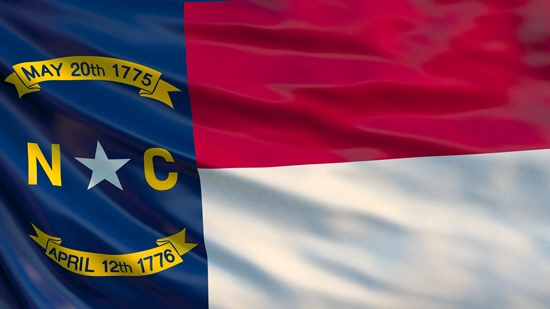
Nearby Labcorp Blood Testing facilities:
- Labcorp Center Distance: 1 m, 1126 N Church St Ste 104, Greensboro, Guilford County, NC, 27401
- Labcorp Center Distance: 10 m, 3610 Peters Court Suite 200, High Point, Guilford County, NC, 27265
- Labcorp Center Distance: 15 m, 445 Pineview Dr Ste 210, Kernersville, Forsyth County, NC, 27284
- Labcorp Center Distance: 16 m, 1041 Kirkpatrick Rd, Burlington, Alamance County, NC, 27215
- Labcorp Center Distance: 18 m, 855 Heather Rd, Burlington, Alamance County, NC, 27215
- Labcorp Center Distance: 19 m, 1818 Richardson Drive Ste C, Reidsville, Rockingham County, NC, 27320
- Labcorp Center Distance: 20 m, 520 Maple Ave Ste A, Reidsville, Rockingham County, NC, 27320
- Labcorp Center Distance: 22 m, 137 Mt. Calvary Road Suite B, Thomasville, Davidson County, NC, 27360
- Labcorp Center Distance: 24 m, 610 N Fayetteville St. Ste 110, Asheboro, Randolph County, NC, 27203
- Labcorp Center Distance: 28 m, 3333 Brookview Hills Ste 103, Winston Salem, Forsyth County, NC, 27103
- Labcorp Center Distance: 29 m, 3940 Arrowhead Blvd Ste 240, Mebane, Alamance County, NC, 27302
- Labcorp Center Distance: 34 m, 7122 Village Medical Circle, Clemmons, Forsyth County, NC, 27012
- Labcorp Center Distance: 41 m, 174 Executive Drive Ste C, Danville, Other, VA, 24541
- Labcorp Center Distance: 45 m, 5324 Mcfarland Drive Ste 100, Durham, Durham County, NC, 27707
- Labcorp Center Distance: 46 m, 601 Mocksville Ave Ste B, Salisbury, Rowan County, NC, 28144
- Labcorp Center Distance: 47 m, 18877 Jeb Stuart Highway, Stuart, Patrick County, VA, 24171
- Labcorp Center Distance: 49 m, 107 Weeks Drive, Roxboro, Person County, NC, 27573
- Labcorp Center Distance: 53 m, 1133 Carthage Street Unit De, Sanford, Lee County, NC, 27330
- Labcorp Center Distance: 54 m, 752 S Andy Griffith Pkwy, Mount Airy, Surry County, NC, 27030
- Labcorp Center Distance: 55 m, 3601 Davis Drive, Morrisville, Wake County, NC, 27560
- Labcorp Center Distance: 56 m, 1021 W Williams St Ste 102, Apex, Wake County, NC, 27502
- Labcorp Center Distance: 60 m, 222 Ashville Ave Suite 10, Cary, Wake County, NC, 27518
- Labcorp Center Distance: 61 m, 104 Bass Lake Road Suite 100, Holly Springs, Wake County, NC, 27540
- Labcorp Center Distance: 62 m, 8 Regional Circle, Pinehurst, Moore County, NC, 28374
- Labcorp Center Distance: 63 m, 3200 Blue Ridge Road Ste 200, Raleigh, Wake County, NC, 27607
- Labcorp Center Distance: 64 m, 8300 Health Park Suite 223, Raleigh, Wake County, NC, 27615
- Labcorp Center Distance: 66 m, 6729 Falls Of Neuse Rd Ste 102, Raleigh, Wake County, NC, 27615
- Labcorp Center Distance: 67 m, 11001 Durant Road Ste 106, Raleigh, Wake County, NC, 27614
- Labcorp Center Distance: 69 m, 134 Medical Park Rd Ste 102, Mooresville, Iredell County, NC, 28117
- Labcorp Center Distance: 70 m, 10831 Forest Pines Dr Ste 108, Raleigh, Wake County, NC, 27614
- Labcorp Center Distance: 71 m, 100 South 10Th Street, Lillington, Harnett County, NC, 27546
- Labcorp Center Distance: 74 m, 16525 Holly Crest Lane 250, Huntersville, Mecklenburg County, NC, 28078
- Labcorp Center Distance: 75 m, 10030 Gilead Road Ste 100-B, Huntersville, Mecklenburg County, NC, 28078
- Labcorp Center Distance: 76 m, 1902 West Park Drive, North Wilkesboro, Wilkes County, NC, 28659
- Labcorp Center Distance: 78 m, 95 Springbrook Ave. Ste. 107, Clayton, Johnston County, NC, 27520
- Labcorp Center Distance: 83 m, 1500 Matthews Twnshp Pkwy1147, Matthews, Mecklenburg County, NC, 28105
- Labcorp Center Distance: 85 m, 400 East Burwell St, Salem, Other, VA, 24153
- Labcorp Center Distance: 86 m, 2149 Valleygate Dr Suite 101, Fayetteville, Cumberland County, NC, 28304
- Labcorp Center Distance: 87 m, 5305 Valley Park Dr Ste 7, Roanoke, Roanoke County, VA, 24019
- Labcorp Center Distance: 89 m, 328 N Brightleaf Blvd, Smithfield, Johnston County, NC, 27577
- Labcorp Center Distance: 90 m, 10512 Park Rd Ste 107, Charlotte, Mecklenburg County, NC, 28210
- Labcorp Center Distance: 92 m, 15830 Ballantyne Med Pl Ste140, Charlotte, Mecklenburg County, NC, 28277
- Labcorp Center Distance: 93 m, 640 Summit Crossing Pl Ste 206, Gastonia, Gaston County, NC, 28054
Nearby Quest Blood Testing facilities:
- Quest Center Distance: 1 m, 1002 N Church St, Greensboro, Guilford County, NC, 27401-1448
- Quest Center Distance: 28 m, 200 Charlois Blvd, Winston Salem, Forsyth County, NC, 27103-1536
- Quest Center Distance: 46 m, 611 Mocksville Ave, Salisbury, Rowan County, NC, 28144-2738
- Quest Center Distance: 60 m, 103 Baines Court, Cary, Wake County, NC, 27511-6646
- Quest Center Distance: 61 m, 530 New Waverly Pl, Cary, Wake County, NC, 27518-7414
- Quest Center Distance: 63 m, 509 Brookdale Dr, Statesville, Iredell County, NC, 28677-4107
- Quest Center Distance: 65 m, 1014 Procure St., Fuquay Varina, Wake County, NC, 27526-2620
- Quest Center Distance: 69 m, 3031 New Bern Ave, Raleigh, Wake County, NC, 27610-2989
- Quest Center Distance: 77 m, 381 Ruin Creek Rd, Henderson, Vance County, NC, 27536-2932
- Quest Center Distance: 81 m, 2001 Crystal Spring Ave Sw, Roanoke, Other, VA, 24014-2465
- Quest Center Distance: 83 m, 1932 Braeburn Drive, Salem, Other, VA, 24153-7302
- Quest Center Distance: 84 m, 202 8Th St, Radford, Other, VA, 24141-2426
- Quest Center Distance: 85 m, 4655 Cleburne Blvd, Dublin, Pulaski County, VA, 24084-4412
- Quest Center Distance: 86 m, 1840 Owen Dr, Fayetteville, Cumberland County, NC, 28304-3455
- Quest Center Distance: 88 m, 1781 Tate Blvd South East, Hickory, Catawba County, NC, 28602-4218
- Quest Center Distance: 90 m, 11111 Carmel Commons Blvd, Charlotte, Mecklenburg County, NC, 28226-4075
Greensboro Hormone Replacement Therapy Services
The Conscious Evolution Institute is a proud provider of quality Hormone Optimization and Restoration Treatments to the Greensboro, North Carolina Area, as well as the greater Research Triangle area. We specialize in Hormone Treatments that allow men and women over the age of thirty to look and feel their best as they grow older. Hormone Deficiency is one of the leading causes of age-related decline, and study after study shows that, by returning Hormone Levels to those associated with early adulthood, it is possible to mitigate many issues related to the aging process, allowing patients to potentially live longer and healthier lives.
If you live in the Greensboro area, including McLeansville, Jamestown, Pleasant Garden, or Summerville, we encourage you to contact us by phone or via the form on this page in order to learn more about the fantastic HRT Services that we provide.
Greensboro Bio-Identical Human Growth Hormone Treatments for HGH Deficiency
Among the most asked-about Hormone Therapy Regimens that we offer at our Greensboro HRT Clinic is Bio-Identical HGH Therapy. Human Growth Hormone is one of the most important hormones produced by the human body, released by the pituitary gland in order to spur cellular metabolism and foster healthy physiological growth and maintanence. HGH plays a role in the function of practically every system of the body, and, starting around the age of thirty, our HGH Levels fall into a state of slow and steady decline.
If you feel that your body simply isn't operating at a functional level which allows you to live the life that you want to live, this could very well be the result of HGH Imbalance, slowing your body down and preventing it from adequately meeting its own needs. We can help you meet a Greensboro HGH Doctor that can perform the necessary tests to evaluate your Hormone Status.
Greensboro Recombinant Sermorelin Acetate Treatments for Growth Hormone Deficiency
Along with Recombinant HGH Therapy, we also offer Sermorelin Therapy to our patients, which can effectively balance Human Growth Hormone Levels while also providing some functional benefits that can make it even more effective than Real HGH for some patients. Sermorelin increases HGH Levels by stimulating the pituitary to produce its own Human Growth Hormone. Because of the way that the treatment works, the body is still able to effectively regulate the production of the hormone, preventing accidental overdose and tachyphylaxis while also promoting more natural patterns of hormone release.
Greensboro Low-T Treatments for Testosterone Deficiency and Andropause
Our Greensboro Hormone Specialists also provide Testosterone Therapy for men suffering from Age-Related Low-T, most notably associated with reduced sex drive, sexual performance, and erectile function. If you have been experiencing issues related to erectile dysfunction, along with unexplained changes in muscle mass or bodyfat percentage, you can likely benefit from Testosterone Therapy using Low-T Creams, Gels, Injections, or Patches. Allow a licensed Greensboro HRT Clinic to evaluate your Testosterone Levels and see if you qualify for therapy.
Greensboro HCG for Dieting and Weight Loss
Not all of the treatments that we offer are used explicitly to balance Hormone Levels, some are recombinant HRT Therapies designed to simply improve your health and wellness, such as HCG Therapy. HCG Injections, when combined with a sufficiently low calorie diet, can help promote fast weight loss of up to 30 pounds in 30 days for patients that are obese or overweight and are looking toward medical strategies to promote weight loss. If you want to learn more about how HCG works and if it can benefit you, we encourage you to give us a call!
Greensboro, North Carolina Information
Greensboro is the 3rd-most populated city in the state of North Carolina, and is located in the heart of the Piedmont Triad, between Winston-Salem and Durham. The city is home to the University of North Carolina at Greensboro, as well as Greensboro College, Elon University School of Law, and Bennett College.
The economy of Greensboro has long relied on very traditional forms of commerce, most notably furniture, tobacco, and textiles, but, in the 21st century, the opportunities in the city continue to grow, especially as a result of its accessible location along three major interstate routes. It is an important logistical center, and its location among other important cities in North Carolina make it not only an important area for commerce, but a prime location for families that move into the area to maximize their economic opportunity.
Major private companies that have a large employment presence in the city include TE Connectivity, American Express, Bank of America, and Cone Health. USPS and FedEx both have transportation hubs in the city as well. Greensboro, perhaps to the surprise of many, has a thriving artistic community, with a wide variety of attractions and regular features. Among these attractions are the Greensboro Opera Company, the Elsewhere Collaborative, the Community Theatre of Greensboro, and the Carolina Theatre of Greensboro.
All About Greensboro, North Carolina Geographic Area
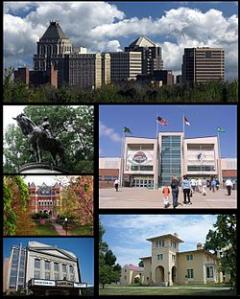

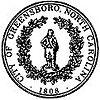
Greensboro  i/ËnÉ¡riËanzbÊuroÊo/ is a city in the U.S. state of North Carolina. It is the third-largest city by population in North Carolina and the largest city in Guilford County and the surrounding Piedmont Triad metropolitan region. According to the 2011 U.S. Census Estimate, Greensboro's population is 273,425.
i/ËnÉ¡riËanzbÊuroÊo/ is a city in the U.S. state of North Carolina. It is the third-largest city by population in North Carolina and the largest city in Guilford County and the surrounding Piedmont Triad metropolitan region. According to the 2011 U.S. Census Estimate, Greensboro's population is 273,425.
The city is located at the intersection of two major interstate highways (I-85 and I-40) in the Piedmont region of central North Carolina.
In 2003, the previous Greensboro ae Winston-Salem ae High Point metropolitan statistical area (MSA) was re-defined by the U.S. Office of Management and Budget, resulting in the formation of the Greensboro-High Point MSA and the Winston-Salem MSA. The 2010 population for the Greensboro-High Point MSA was 723,801. The Greensboro ae Winston-Salem ae High Point combined statistical area (CSA), popularly referred to as the Piedmont Triad, had a population of 1,599,477.
In 1808, Greensborough (as was the spelling prior to 1895) was planned around a central courthouse square to succeed the nearby town of Guilford Court House as the county seat. This act moved the county courts closer to the geographical center of the county, a location more easily reached by the majority of the county's citizens.
Greensboro has grown to be part of a metropolitan area called the Triad, which encompasses three major cities (Greensboro, High Point, and Winston-Salem), as well as many medium sized and smaller communities. Greensboro evolved from a small center of government to an early 1900s textile and transportation hub. In 2004 the Department of Energy (DOE) awarded Greensboro with entry into the Clean Cities Hall of Fame.
The city was named for Major General Nathanael Greene, commander of the American forces at the Battle of Guilford Court House on March 15, 1781. Although the Americans lost the battle, Greene's forces inflicted such heavy casualties on the British Army of General Charles Cornwallis that Cornwallis chose to pull his battered army out of North Carolina and into Virginia. This decision allowed a combined force of American and French troops to trap Cornwallis at Yorktown, Virginia, where the British were forced to surrender on October 19, 1781, after a 20-day siege, thus ending the military phase of the American Revolution. As such, Greene's successful efforts at weakening the British Army played a key role in securing America's victory over the British.
Greensboro was established near the geographic center of Guilford County, on land that was "an unbroken forest with thick undergrowth of huckleberry bushes, that bore a finely flavored fruit." Property for the future village was purchased for $98, and three north-south streets (Greene, Elm, Davie) were laid out intersecting with three east-west streets (Gaston, Market, Sycamore). The courthouse stood at the center of the intersection of Elm and Market streets. By 1821, the town was home to 369 residents.
In the early 1840s, Greensboro was selected by the state government at the request of then Governor Morehead (whose estate, Blandwood, is located in Greensboro) for inclusion on a new railroad line. The city grew substantially in size and soon became known as the "Gate City" due to its role as a transportation hub for the state. The railroads transported goods to and from textile mills, which grew up with their own mill villages around the city. Many of these businesses remained in the city until the 21st century, when most of them went bankrupt, reorganized, and/or merged with other companies. Greensboro remains as a major textile headquarters city with the main offices of International Textile Group (Cone, Burlington Industries), Galey & Lord, Unifi, and VF Corporation (Wrangler, Lee, The North Face, Nautica). The importance of rail traffic continues for the city, as Greensboro serves as a major regional freight hub, and four Amtrak passenger trains stop in Greensboro daily on the main Norfolk Southern line between Washington and New Orleans by way of Atlanta.
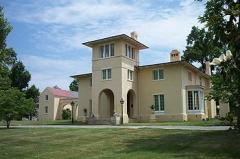
Though the city developed slowly, early wealth generated from cotton trade and merchandising led to the construction of several notable buildings. The earliest building, later named Blandwood Mansion and Gardens, was built in 1795. Additions to this residence in 1846 designed by Alexander Jackson Davis of New York City made the house an influential landmark in the nation as America's earliest Tuscan Villa. Other significant estates followed, including "Dunleith" designed by Samuel Sloan, Bellemeade, and the Bumpass-Troy House (now operating as an inn).
Although Guilford County did not vote for secession, once North Carolina joined the Confederacy some citizens joined the Confederate cause, forming such infantry units as the Guilford Grays. From 1861 to March 1865 the city was relatively untouched by the American Civil War, with the exception of dealing with shortages of clothing, medicines, and other items caused by the US naval blockade of the South. However, in the final weeks of the war, Greensboro played a significant role. In April 1865 General P.G.T. Beauregard was instructed by the commanding officer of the Army of Tennessee, General Joseph E. Johnston, to prepare for a defense of the city. During this time, Confederate President Jefferson Davis and the remaining members of the Confederate cabinet had evacuated the Confederate Capital in Richmond, Virginia, and moved south to Danville, Virginia. When Union cavalry threatened Danville, Davis and his cabinet managed to escape by train and reassembled in Greensboro on April 11, 1865. While in Greensboro, Davis and his cabinet decided to try to escape overseas to avoid capture by the victorious Union forces; they left Greensboro and separated. As such, Greensboro is notable as the last place the entire Confederate government met as a group, and Greensboro is thus the "final" capital city of the Confederacy. At nearly the same time, Governor Zebulon B. Vance fled the capital of North Carolina in anticipation of the arrival of Union General William Tecumseh Sherman. For a brief period beginning April 16, 1865, the capital of North Carolina was maintained in Greensboro. After the negotiations were completed at Bennett Place, now in present day Durham, North Carolina, between General Johnston and General Sherman on April 26, 1865, Confederate soldiers stacked their arms and received their paroles in Greensboro, and then headed for home.
In the 1890s, the city continued to attract attention from northern industrialists, including Moses and Caesar Cone of Baltimore. The Cone brothers established large-scale textile plants, changing Greensboro from a village to a city within a decade. By 1900, Greensboro was considered a center of the Southern textile industry, with large scale factories producing denim, flannel, and overalls. Prosperity brought to the city through textiles resulted in the construction of notable twentieth century civic architecture, including the Guilford County Courthouse, West Market Street Methodist Church by S. W. Faulk, several buildings designed by Frank A. Weston, and UNCG's Main Building designed by Orlo Epps.
During the twentieth century, Greensboro continued to expand in wealth and population. Rapid growth led to construction of grand commercial and civic buildings, many of which remain standing today, designed by hometown architects Charles Hartmann and Harry Barton. Other notable industries became established in the city, including Vicks Chemical Co. (famous for over-the counter cold remedies such as VapoRub and NyQuil), Carolina Steel Corporation, and Pomona Terra Cotta Works. During this period of growth, Greensboro experienced an acute housing shortage. Builders sought to maintain a construction goal of 80 to 100 affordable housing units per year in order to provide homes for workers. Greensboro's real estate was considered "the wonder of the state" during the 1920s. Growth continued through the Great Depression, as Greensboro added an estimated 200 new families per year to its population. The city earned a reputation as a well-planned community, with a strong emphasis on education, parks, and a profitable employment base.
Prosperity brought new levels of development involving nationally and internationally known architects. Walter Gropius designed a factory building in the city in 1944. Greensboro-based Ed Loewenstein contributed designs for projects throughout the region. Eduardo Catalano, and George Matsumoto both brought designs to the city that challenged North Carolinians with modernist architectural concepts and forms.
In 1960, the Census Bureau reported Greensboro's population as 74.0% white and 25.8% black. As Greensboro evolved into one of North Carolina's primary cities, changes began to occur within its traditional social structure. On February 1, 1960, four black college students from North Carolina Agricultural and Technical College sat down at an all-white Woolworth's lunch counter, and refused to leave after they were denied service. The four students purchased small items in other parts of the store and kept their receipts, then sat down at the lunch counter and asked to be served. After being denied service, they produced their receipts and asked why their money was good everywhere else at the store, but not at the lunch counter. Hundreds of others soon joined in this sit-in, which lasted several months. Such protests quickly spread across the South, ultimately leading to the desegregation of Woolworth's and other chains. The original lunch counter and stools where the four first sat are still in their original location, now home to the International Civil Rights Center and Museum (though a section of the counter is also on display at the Smithsonian). The museum opened on February 1, 2010, the 50th anniversary of the sit-ins.
After the desegregation of Woolworth's and other minor concessions by Greensboro's white community, a brief period of patience and negotiation was followed by further protests in 1962 and 1963, culminating in the largest civil rights protest to take place in North Carolina history during May and June 1963. In addition to the desegregation of public accommodations, protestors sought economic and social justice, such as hiring policies based on merit and the integration of public schools. Marches of over 2,000 protesters per night took place in Greensboro's segregated central business district. William Thomas and A. Knighton Stanley, coordinators of Greensboro's local CORE chapter, invited Jesse Jackson, then a student at A&T to join the protests, and Jackson quickly rose to prominence as a student leader and public representative of the protest movement. To invoke arrest by violating segregation rules of local businesses, trespassing, and other non-violent breaches of the law, soon became a primary tactic of the protestors, especially among college and high school students. Seeking to overflow city jails and overburden municipal resources, at one point approximately 1,400 blacks occupied Greensboro's jails, which drew serious attention from both Greensboro's mayor and Governor of North Carolina Terry Sanford. In the end, the protests achieved gains toward racial equality in the form of further desegregation, reformed hiring policies in city government, and commitments to progress by Greensboro's mayor and Governor Sanford, who declared, "Anyone who hasn't received this message doesn't understand human nature." However, though these concessions helped build progressive momentum, significant change in race relations came about at a painfully slow pace, and verbal commitments from white leadership in 1963 proved to be more symbolic victories than substantial ones.
In May, 1969, A&T was involved in a second incident when the students of James B. Dudley High School appealed to them when a popular candidate for student union class president was refused, allegedly due to his position with Youth for the Unity of Black Society. On May 21, after student protesters began throwing rocks and were confronted by police with tear gas canisters, an uprising led to gunfire exchanges between protesters, police and the National Guard. Escalating violence eventually led to the invasion of the A&T campus by what was described at the time as "the most massive armed assault ever made against an American university". The uprising ended soon after the National Guard made a sweep of A&T college dormitories, taking hundreds of students into protective custody. A report released by the North Carolina State Advisory Committee to the United States Commission on Civil Rights found the National Guard invasion reckless and disproportionate to the actual danger, and criticized local community leaders for failing to help the Dudley High School students when the issues first emerged. They declared it "a sad commentary that the only group in the community who would take the Dudley students seriously were the students at A&T State University."
In spite of this period of progress, old wounds had yet to heal and prejudices continued. On November 3, 1979, members of the Communist Workers Party (CWP) were holding an anti-Ku Klux Klan rally, when two cars containing KKK supporters drove into the Morningside Heights neighborhood where the rally was being held and opened fire on the protest. Four local TV news stations filmed the event as it happened. A pistol was fired by a CWP organizer (allegedly into the air) and the Klan cars was beaten with sticks prior to the shooting. Five of the anti-Klan demonstrators were killed and seven were wounded. Television footage of the event was shown nationwide and around the world, and the event became known as the Greensboro Massacre. In November 1980 six of the accused KKK supporters were all acquitted by an all-white jury after a week of deliberations. In 1985, a civil suit found five police officers and two other individuals liable for $350,000 in damages to be paid to the Greensboro Justice Fund.
Greensboro is governed under a Council-Manager system. As of December, 2011: Robbie Perkins (R) is the mayor. The City Council Members are: Yvonne J. Johnson (D), Mayor Pro-Tempore, At Large; Nancy Vaughan (Unaffiliated), At Large; Marikay Abuzuaiter (D), At Large; T. Dianne Bellamy-Small (D), District 1; Jim Kee (D), District 2; Zach Matheny (R), District 3; Nancy Hoffmann (D), District 4; and Trudy Wade (R), District 5. The Mayor and Council Members serve two-year terms, with elections held biennially.
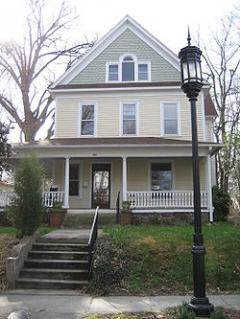
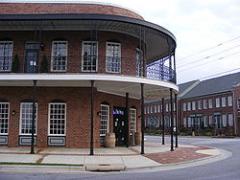
Greensboro's earliest neighborhood is College Hill, located between West Market Street and Spring Garden Street, in and around Greensboro College.
Southside is among the oldest neighborhoods in the city and has experienced major redevelopment.
The Aycock and Fisher Park neighborhoods were established in 1895 and 1901, respectively. The Aycock neighborhood features large Queen Anne residences of the turn-of-the-twentieth century, as well as Foursquare, Craftsman, and Colonial Revival styles.
The Manchester Village, established in the early 1920s, was home to prominent business leaders and government officials. It was considered to be the most affluent neighborhood, with large estates that were destroyed in the late 1980s for commercial development.
Irving Park, developed in 1911 around the golf course of the Greensboro Country Club, was modeled on nearby Pinehurst by designer John Nolan. The prestigious neighborhood includes large homes on ample lots, and remains popular today.
Glenwood is a neighborhood that occupies the southwestern part of the city. It is bordered by the Greensboro Coliseum, Lee St., and the University of North Carolina at Greensboro. Glenwood is a diverse neighborhood of 1970's ranch homes, smaller homes built in the 1950s, and subsidized housing. The neighborhood has suffered decline over the past few years, but there are signs of renewal as UNC-Greensboro students and faculty move to the area adjacent to Lee St.
The Warnersville neighborhood was a once thriving area in south Greensboro. When Urban Renewal was initiated in the mid-1900s, most of the business and homes were destroyed and replaced with new roads and development. However, this area has not recovered still. Remnants of the once booming Ashe St. can be seen behind the Greensboro Urban Ministry on Eugene St.
The urbanization of Greensboro during the early twentieth century was influenced greatly by the popularity of the automobile, which enabled citizens to live farther from the city center in more suburban surroundings. A series of "streetcar suburbs" were established, including Glenwood, Hamilton Lakes, Lake Daniel, Latham Park, Lindley Park, O. Henry Oaks, Rankin, Starmount, Sunset Hills and Westerwood. Many of these neighborhoods include some of the city's finest public parks. Recent neighborhood additions include sprawling large-scale planned unit developments such as Adams Farm, Lake Jeanette, The Cardinal, New Irving Park, and Reedy Fork Ranch.
Greensboro maintains a "sister city" relationship with three cities in order to foster international friendship and cooperation.
Greensboro is located at 36 °4 a²48 a³N 79 °49 a²10 a³W / 36.08 °N 79.81944 °W / 36.08; -79.81944 (36.079868, na79.819416).
According to the United States Census Bureau, the city has a total area of 109.2 square miles (283 km2), of which, 104.7 square miles (271 km2) of it is land and 4.5 square miles (12 km2) of it (4.16%) is water.
Greensboro is situated among the gently rolling hills of North Carolina's Piedmont and is situated midway between the state's Blue Ridge and Great Smoky mountains to the west and the Atlantic beaches and Outer Banks to the east. The view of the city from its highest building aethe Lincoln Financial tower (commonly known as the Jefferson-Pilot Building) aereveals that the town is populated with large numbers of green trees, lending perhaps another dimension of significance to its name. The city is at the nexus of several major freeways, with Interstates 40, 85, and the planned I-73 passing through its borders.
Thunderstorms are common during the humid spring and summer months, some being severe in nature. On April, 2 1936, at around 7:00pm, a large, F-4 tornado cut a seven-mile (11 km) swath of destruction through southern Greensboro. 14 people were killed and 144 were injured as the tornado moved through the city, including part of downtown. The storm was part of an outbreak known as the 1936 Cordele-Greensboro tornado outbreak. Strong tornadoes have struck the Greensboro area since then, notably Stoneville, North Carolina on March 20, 1998, Clemmons, North Carolina and Winston-Salem, North Carolina on May 5, 1989 and Clemmons, North Carolina and Greensboro on May 7, 2008, High Point, March 28, 2010
In a pattern usually seen in urban areas within the US, Greensboro tends to have crime levels considerably higher than the national average. The same pattern usually dictates segregated/pocketed crime which is the trend in Greensboro as well, where a very high percentage of crime takes place in minority populated/low income neighborhoods.[original research?]
The Center for New North Carolinians details more information about Greensboro's ethnic and cultural diversity.
As of the census of 2010, there were 269,666 people; 124,074 households; and 53,958 families residing in the city. The population density was 2,138.3 people per square mile (825.6/km ²). There were 99,305 housing units at an average density of 948.4 per square mile (366.2/km ²). The racial composition of the city was: 48.4% White, 40.6% Black or African American, 7.5% Hispanic or Latino American (4.6% Mexican, 0.7% Puerto Rican), 4.0% Asian American (1.6% Vietnamese, 0.7% Indian), 0.5% Native American, 0.1% Native Hawaiian or Other Pacific Islander, 2.08% some other race, and 2.6% two or more races. Non-Hispanic Whites were 45.6% of the population in 2010, compared to 70.9% in 1970.
Of the estimated 92,394 households in the city in 2000, 27.5% included children under the age of 18, 39.8% were married couples living together, 14.6% had a female householder with no husband present, and 41.6% were classified as nonfamily. Of the total households, 32.6% were composed of individuals, while 8.7% reported someone living alone who was 65 years of age or older. The average household size was 2.30 persons, and the average family size was 2.94 persons.
The age distribution in 2000 was 22.3% under the age of 18, 14.1% from 18 to 24, 31.6% from 25 to 44, 20.2% from 45 to 64, and 11.9% who were 65 years of age or older. The median age was 33 years. For every 100 females there were 89.2 males aefor every 100 females age 18 and over, there were 85.6 males.
The median income for a household in the city in 2000 was $39,661, and the median income for a family was $50,192. Males had a median income of $34,681 versus $26,797 for females. The per capita income for the city was $22,986. About 8.6% of families and 19.3% of the population in 2000 were living below the poverty line, including 25.8% of those under age 18 and 10.6% of those age 65 or over.
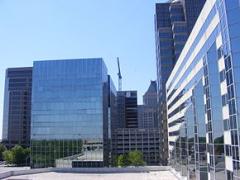
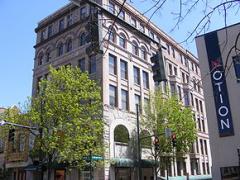
The Greensboro economy and the surrounding Piedmont Triad area, traditionally has been centered around textiles, tobacco, and furniture. Greensboro's central proximity in the state has made it a popular place for families and businesses, as well as becoming more of a logistical hub with FedEx having regional operations based in the city.
Notable companies headquartered in Greensboro include the Honda Aircraft Company, Lorillard Tobacco Company, Kayser-Roth, VF, Syngenta Crop Protection, Mack Trucks, Volvo Trucks of North America, RF Micro Devices, the International Textile Group, NewBridge Bank, The Fresh Market, Cook Out, Ham's, Biscuitville, Tripps, Gilbarco Veeder-Root, Daimler Buses and Columbia Forest Products. Greensboro is also a "center of operations" for the insurance company Lincoln Financial Group. Greensboro is also headquarters to the Atlantic Coast Conference. Although traditionally associated with the textile and tobacco industries, Greensboro leaders are working to attract new businesses in the nanotech, high-tech and transportation/logistics sectors. The University of North Carolina at Greensboro and North Carolina A&T State University opened a joint research park, Gateway University Research Park. O'Reilly Auto Parts has recently chosen Greensboro as a location for a large distribution center and expects to hire 400 ae500 more employees once it is fully open and functional.
According to the City's 2010 Comprehensive Annual Financial Report, the largest employers in the city are:
Downtown Greensboro has experienced construction investment in recent years with developments such as NewBridge Bank Park, and residential developments and office construction. The Southside neighborhood downtown exemplifies central-city reinvestment as a formerly economically depressed neighborhood that has been redeveloped into an award-winning neotraditional-style neighborhood. Downtown Greensboro also has experienced a dramatic increase in nightlife with the opening of numerous nightclubs, bars and restaurants. The entire redevelopment of the downtown was aided by the 2006 opening of the Elon University School of Law. The law school is credited with bringing student dollars to the downtown both day and at night. Moreover, the influx of nearly 300 highly educated men and women from across the country has added to the cosmopolitanism of the downtown. Additional human capital has been developed by innovative artistic ventures like the Elsewhere Artists Collaborative, which attracts some of the most promising young artists from around the world to live and create in a 24/7 art installation.
Additional downtown attractions include: the Carolina Theater, Triad Stage (Pyrle Gibson Theater), Blandwood Mansion, Center City Park, NewBridge Bank Park, Greensboro Historical Museum, Greensboro Cultural Center, the J. Douglas Galyon Transportation Depot, and the Greensboro Children's Museum. A multi-million dollar greenway loop around downtown is currently under construction. It will be among the first urban greenway loops in the country and will have walking paths, biking paths, parks, recreational facilities, outdoor classrooms, and art show spaces. The project is being built in phases and could take 5 to 10 years to complete and will also connect with the greenway system throughout the city.
Located at 3121 High Point Road, the Four Seasons Town Centre sits just outside the downtown area. It is a multi building complex developed by the Koury Corporation. It includes multiple hotels, most prominently the Koury Convention tower and a shopping mall. Boasting over 250,000 square feet (20,000 m2) of flexible meeting space, the Joseph S. Koury Convention Center is the largest convention hotel between Atlanta, Georgia and Washington, D.C.. In 1990, the convention center opened next to the Holiday Inn Four Seasons (now Sheraton Four Seasons). In 1994 the 28 story hotel tower was constructed atop the Koury Convention Center bringing the room total of the complex to well over 1,000. The Four Seasons Town Center mall sits just behind the convention center and is a popular shopping attraction for the entire piedmont triad.
The Greensboro Coliseum is located .9 miles (14 km) down High Point Road. Many of the city's major events take place between the convention center and the coliseum. A new ACC Hall of Fame and an $18.3 million aquatics center are planned to be built on site starting in 2010.
In 1998, FedEx chose to build and operate a $300 million mid-Atlantic air-cargo and sorting hub at Piedmont Triad International Airport, following an intensive competition for the hub among other regions of the state, as well as locations in South Carolina. After the hub announcement, the project faced court battles concerning potential noise and pollution abatements from neighborhoods located near the planned hub site. Nonetheless, the hub opened in 2009 is building on the city's effort to strengthen its position as a transportation, distribution and logistics hub in the Southeast and middle Atlantic regions.
In February 2007, Honda Aircraft Company announced it will develop a multi-million dollar jet airplane facility and world headquarters at Piedmont Triad International Airport. The company will build the new HondaJet at the site, and the first planes were planned to roll off the assembly line in 2010. In 2001, the test flight for the jet took place at the airport.

The public schools in Greensboro are operated by Guilford County Schools. Guilford County Schools is the third largest school system in the state with about 71,000 students being taught. Greensboro consist of one the oldest public high schools in the state, Grimsley High School, established in 1899 as Greensboro High School, as well of as the The Early College at Guilford, one of the top public schools in the nation.
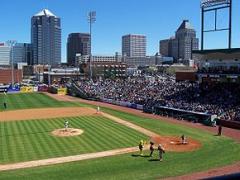
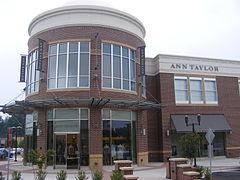
Greensboro is home to a large variety of retail shopping from well-known national chains to local boutiques and galleries. Four Seasons Town Centre, located on the city's southwest side off I-40, is a three-level regional mall with anchors Belk, Dillard's, and JCPenney. Friendly Center, located off Friendly Avenue is an open-air shopping complex featuring Belk, Macy's, Sears, Barnes & Noble Booksellers, the nation's largest Harris Teeter supermarket, Old Navy, and a multiplex cinema. The Shoppes at Friendly Center, adjacent to Friendly Center, is home to many specialty retailers and restaurants, many of which that are exclusive to the Triad area, including Anthropologie, the Apple Store, White House Black Market, Sur La Table, REI, Brooks Brothers, Bravo! Cucina Italiana, P. F. Chang's China Bistro, DSW Designer Shoe Warehouse, and Fleming's Prime Steakhouse & Wine Bar. Additional shopping centers are located primarily on the West Wendover corridor near I-40 and on Battleground Avenue on the city's northwest side. Recently, "big-box" retailers have clustered at the site of the former Carolina Circle Mall on the city's northeast side and on the city's far south along the newly completed Painter Boulevard (I-85).
Greensboro is also home to the largest retail horse depot in the world, located near the famed "Sharpe Family Horse Farm" on Middlesex Drive. First opened in 1894 as a wholesale supplier to the southeastern Pony Express, the farm now sells thoroughbred mares, yearlings, fillies and Arabian horses to an estimated 8,000 private purchasers annually.
Greensboro is not currently home to any top-level professional sports teams. The National Hockey League's Carolina Hurricanes franchise moved to Raleigh from Hartford, Connecticut in 1997, but the team played its first two seasons at the Greensboro Coliseum Complex while its home arena, Raleigh's Entertainment & Sports Arena, was under construction.
The Greensboro Grasshoppers (formerly the Greensboro Bats and the Greensboro Hornets) are a minor league baseball team located in Greensboro. They are a Class A team in the South Atlantic League, and have been a farm team of the Miami Marlins since 2003. They play at NewBridge Bank Park.
Greensboro's Carolina Dynamo play in the USL Premier Development League, USL Professional Division, which is currently the top level men's amateur soccer competition in the United States. It has 64 teams competing in four conferences, split into nine regional divisions. It's considered to be the fourth tier of competition, behind Major League Soccer. The team plays its home games at Macpherson Stadium in nearby Browns Summit, North Carolina, where they have played since 2003. The PDL seasons take place during the summer months, the player pool is drawn mainly from elite NCAA college soccer players seeking to continue playing high level soccer during their summer break, which they can do while still maintaining their college eligibility.
Greensboro is home to the headquarters of the Atlantic Coast Conference, despite having no school participating within the league. The Greensboro Coliseum Complex has hosted the Men's ACC Tournament 23 times since 1967 and the Women's ACC Tournament 12 times since 2000. Greensboro has also hosted the NCAA Men's Basketball Final Four on four occasions.
The PGA Tour holds a tournament annually in Greensboro. The Wyndham Championship is held at Sedgefield Country Club and is the last PGA Tour event before the Playoffs for the FedEx Cup. The tournament was founded in 1938 as the Greater Greensboro Open and one of the oldest events on the PGA Tour.
Greensboro is home to an active and diverse arts community. Events and venues range from the nationally acclaimed annual Eastern Music Festival to Weatherspoon Art Museum to the cutting edge performances of the Triad Stage theater company.
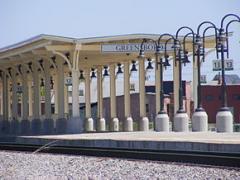
Greensboro is served by Piedmont Triad International Airport, which also serves the nearby cities of High Point and Winston-Salem as well as the surrounding Piedmont Triad metropolitan region. PTI was a hub for the now defunct Skybus Airlines.
Amtrak's daily Crescent, Carolinian and Piedmont trains connect Greensboro with the cities of New York, Philadelphia, Baltimore, Washington, Richmond, Virginia, Raleigh, North Carolina, Charlotte, North Carolina, Atlanta, Birmingham, Alabama and New Orleans.
Amtrak trains, taxis, local and long-distance buses arrive and depart from the Amtrak station and rail depot located at 236-C East Washington Street. Originally constructed in the early 1920s, the station and depot were renovated in 2004.
The Greensboro Transit Authority offers public bus service throughout the city, including a service called Higher Education Area Transit, or HEAT, which links downtown attractions to area colleges and universities. Regional public transportation throughout the metropolitan area is coordinated by PART, Piedmont Area Regional Transportation.
Interstate 40 and Interstate 85 share the same freeway facility for several miles in the Greensboro area. The consolidated highway, which is now the Interstate 40/Business 85 junction, is located just south of downtown and forms the western end of a stretch of freeway known throughout the region as "Death Valley", a congested and accident-prone stretch of roadway where six major federal and Interstate routes combine into a single freeway facility.
Construction is currently underway on the Greensboro Urban Loop, a freeway that, when complete, will encircle the city. Sections of this beltway may form the future alignment of Interstate 73. U.S. Highway 29---which travels through the southern, eastern and northern sections of the city before heading northeast toward suburban Reidsville aeis a major route in Greensboro and offers freeway access to the more urban and central areas of the city.
The Greensboro News & Record is the primary daily newspaper in Greensboro. The Business Journal, a member of the American City Business Journals chain of business weeklies, is based in Greensboro and covers business across the Piedmont Triad metropolitan region. The Carolina Peacemaker is a news weekly that covers the African-American community. The Rhinoceros Times and Yes! Weekly are free-weekly alternative newspapers, and the Hamburger Square Post is a free monthly newspaper.
Greensboro is a part of the Greensboro/Winston-Salem/High Point television designated market area and includes the following commercial broadcast stations (listed by call letters, channel number, network and city of license):
Greensboro is also home to the Triad bureau of News 14 Carolina

Word Count: 5910






